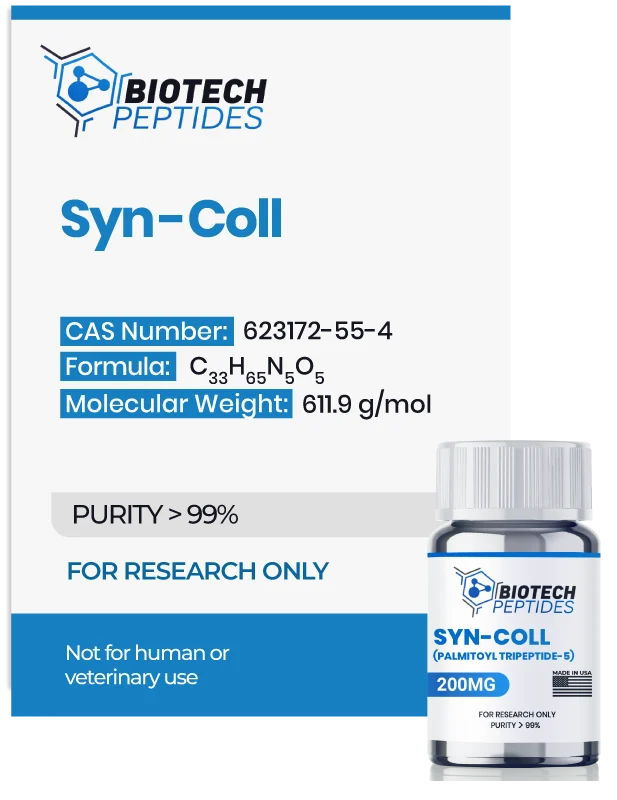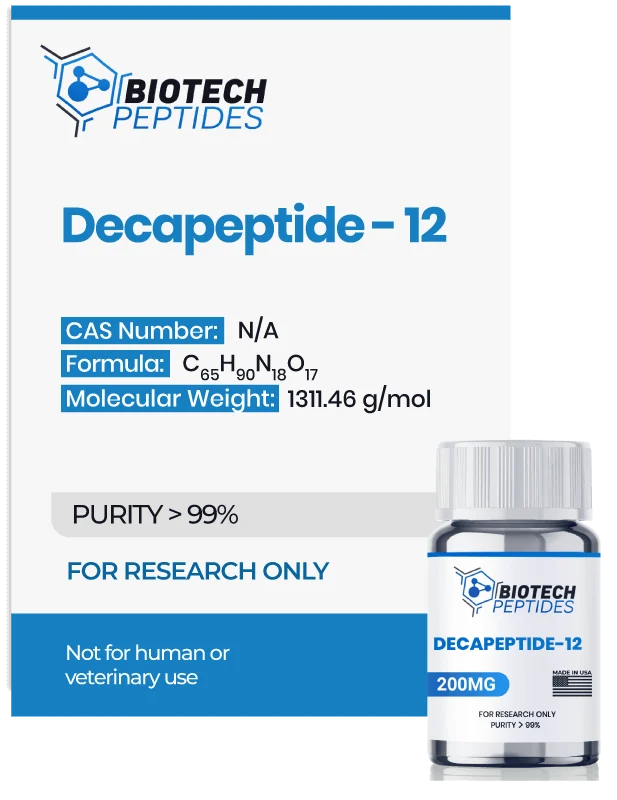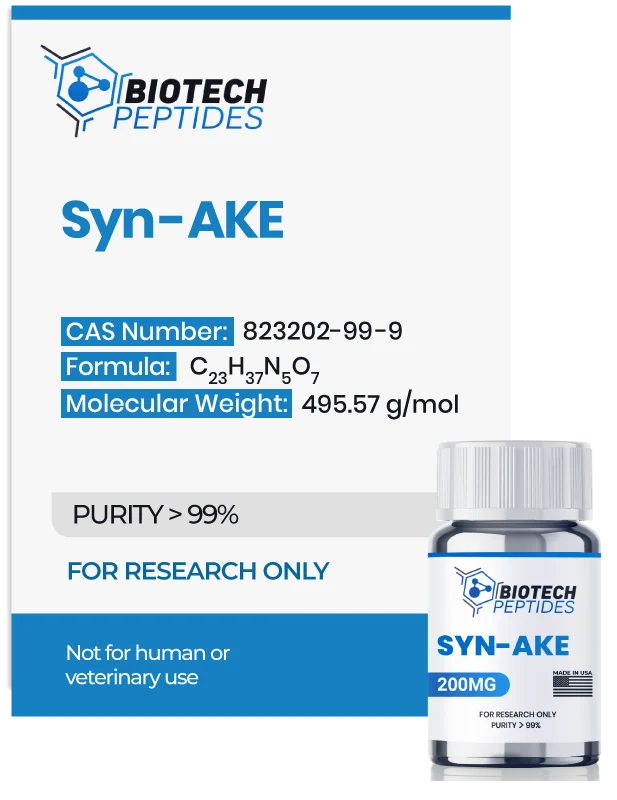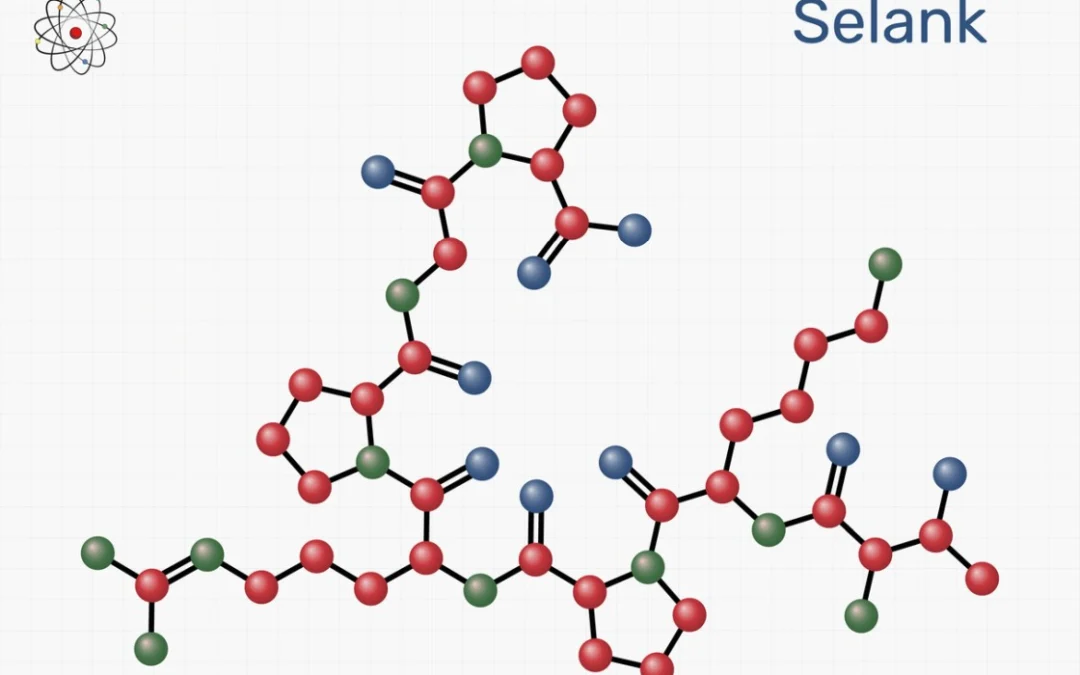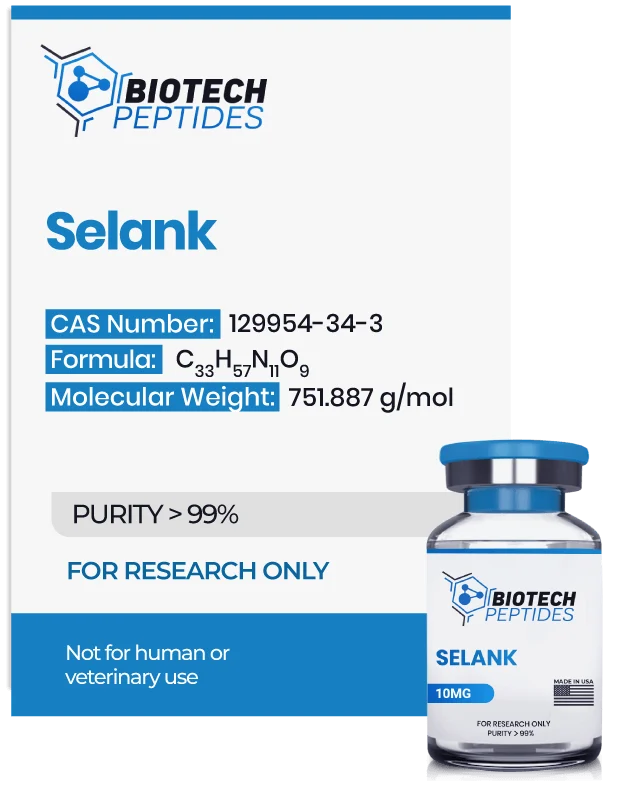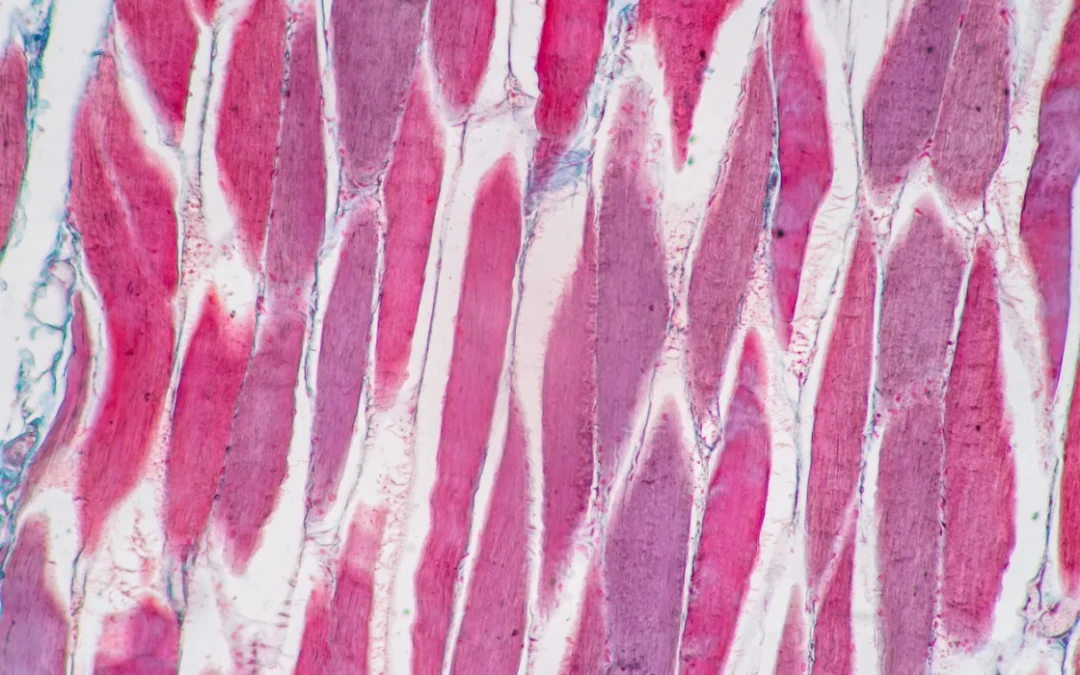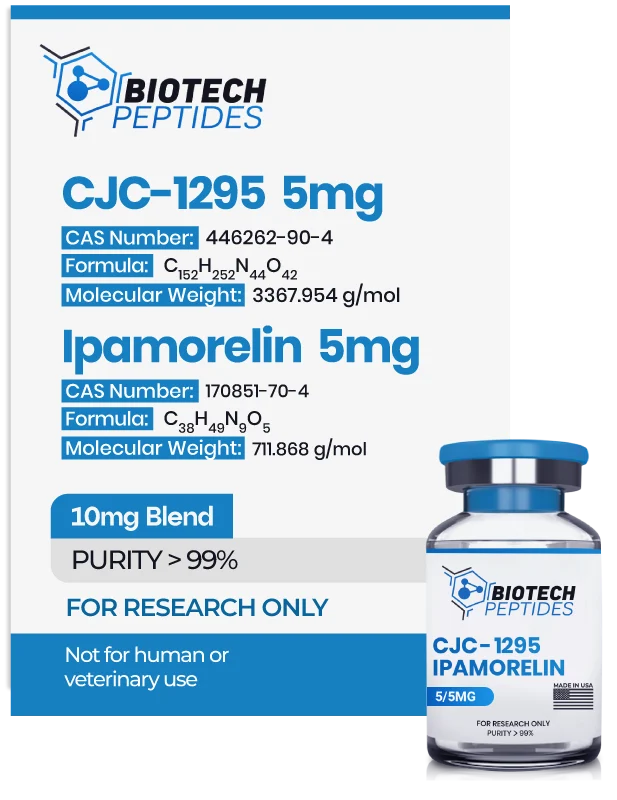
Syn-Coll Tripeptide and Skin Cell Architecture
Research suggests that the design of Syn-Coll was based on short peptide motifs within TSP-1. Specifically, the structure in TSP-1 that has been implicated in stimulating transforming growth factor beta (TGF-β), a regulatory cytokine central to extracellular matrix homeostasis.[2] TGF-β is believed by researchers to influence fibroblast function, regulate extracellular matrix protein turnover, and contribute to postnatal tissue remodeling processes. By structurally mimicking the functional motifs of TSP-1, Syn-Coll may modulate signaling pathways associated with collagen synthesis and matrix stability.
Contents:
- General Overview of Syn-AKE Tripeptide
- Scientific and Research Studies
- References
Generalized Overview
Data from cell culture and animal studies suggests that Syn-Coll may stimulate fibroblast activity via increased TGF-β signaling. This signalling may increase the production of Type I and Type III collagen, which are considered to be the principal fibrillary collagens in dermal architecture.
Reports further suggest that Syn-Coll may exert a dual role in collagen homeostasis: promoting neocollagenesis while inhibiting degradation. The latter action is hypothesized to occur through downregulation of matrix metalloproteinase (MMP-1 and MMP-3), enzymes associated with collagen breakdown and extracellular matrix remodeling. The combination of enhanced collagen synthesis and reduced enzymatic degradation positions Syn-Coll as a peptide of interest in studies investigating extracellular matrix preservation and repair mechanisms.
Scientific Research and Studies
Syn-Coll Tripeptide and Potential Mechanisms of Wrinkle Attenuation
Research in controlled studies suggests that Syn-Coll tripeptide may influence skin cell surface morphology and wrinkle parameters. In one investigation utilizing PRIMOS surface topography, peptide-containing formulations suggested a concentration-dependent reduction in wrinkle depth when compared with placebo groups. Reports from this study[3] hypothesized that Syn-Coll might exhibit several-fold greater activity in reducing wrinkle appearance relative to control formulations.
Additional studies involving delineated cohorts over extended durations (e.g., 84-day protocols) suggest that Syn-Coll may contribute to reductions in skin roughness and wrinkle measurements when compared with placebos or alternative peptide formulations. Reported data in such studies included reductions in wrinkle parameters in the range of approximately 12%.[4]
Beyond modulation of collagen synthesis and matrix degradation, Syn-Coll tripeptide may exert action on skin barrier homeostasis. Findings suggest possible roles in reducing transepidermal water loss, thereby potentially supporting hydration retention.[5] The peptide has been described in some studies as exhibiting humectant-like properties, enhancing water absorption and retention within the stratum corneum. Additional mechanisms may involve increasing surface lipid content, providing emollient activity, and contributing to partial occlusion and lubrication of the skin barrier.
Structural modifications of Syn-Coll have also been explored. For example, conjugation of an L-ascorbate moiety at the C-terminus (Pal-KVK-AA) has been investigated for its potential depigmenting activity. Experimental data suggests that such modifications may interfere with melanin biosynthesis, thereby influencing pigmentation processes associated with photo aging and oxidative stress. These findings highlight the broader scope of Syn-Coll research beyond wrinkle modulation, extending to pigmentation and barrier function pathways.
Syn-Coll Tripeptide and Regulation of Collagen Biosynthesis
Collagen represents a fundamental structural protein within the extracellular matrix (ECM), contributing to dermal integrity and connective tissue organization. Research suggests that Syn-Coll may influence collagen homeostasis by mimicking functional motifs of thrombospondin-1 (TSP-1).[6] This mimicry is hypothesized to facilitate activation of transforming growth factor beta (TGF-β), a regulatory cytokine associated with extracellular matrix regulation.
Studies report that Syn-Coll may promote the activation of latent TGF-β, leading to “a persistent increase in steady-state amounts of type I and type III collagen and fibronectin mRNAs in normal dermal fibroblasts.”[7] Reports also describe a sustained upregulation of messenger RNA transcripts for Type I collagen, Type III collagen, and fibronectin following TGF-β stimulation. Such findings suggest that the peptide may support neocollagenesis through indirect modulation of fibroblast activity.
Comparative investigations have also examined Syn-Coll relative to other synthetic peptides, such as Palmitoyl Pentapeptide. Data from these studies hypothesize that Syn-Coll may be associated with enhanced stimulation of Type I collagen synthesis, with some reports suggesting a greater relative effect, potentially up to 60% higher than Palmitoyl Pentapeptide under certain experimental conditions.
Syn-Coll Tripeptide and the Inhibition of Collagen-Degrading Enzymes
Matrix metalloproteinase (MMPs) are proteolytic enzymes that contribute to extracellular matrix turnover through degradation of structural proteins, including collagen. These enzymes are produced by dermal cells such as fibroblasts and may play essential roles in tissue remodeling and homeostasis. Dysregulated or excessive MMP activity, however, has been associated with accelerated collagen degradation and extracellular matrix destabilization. For example, MMP-1 is a collagenase that targets Type I collagen, while MMP-3 exhibits broader substrate specificity, cleaving multiple extracellular proteins such as collagens, fibronectin, laminin, proteoglycans, and elastin. MMP-3 has also been implicated in the degradation of Type III collagen, a key component of dermal and vascular connective tissue.
Experimental studies suggest that Syn-Coll may exert a protective influence on the extracellular matrix by interfering with MMP-mediated collagen degradation. Reports suggest that the peptide may modulate the activity of MMP-1 and MMP-3, thereby reducing enzymatic breakdown of collagen fibrils and contributing to preservation of dermal matrix architecture.[8]
Recent Studies Involving Syn-Coll and Related Peptide Systems
Recent investigations have explored Syn-Coll tripeptide both as a single agent and in combination with other bioactive compounds, often within advanced delivery systems designed to support peptide stability and dermal penetration.
Nanoparticle-Based Delivery
A review article[9] reported on the development of supramolecular collagen nanoparticles incorporating Palmitoyl tripeptide-5 together with lactoferrin and recombinant collagen. Findings from this formulation suggested potential dermal action including improved hydration, increased firmness, and visible reductions in under-eye puffiness and nasolabial fold depth, with reductions of approximately 10% and 22% respectively.
The precise mechanistic contribution of Syn-Coll within the composite system remains unclear, particularly with respect to established pathways involving TGF-β stimulation and matrix metalloproteinase inhibition.
Synergistic Peptide Formulations
The same review[9] highlighted experimental work using nano liposome formulations containing Syn-Coll in combination with other peptides, including Argireline and Carnosine (or similar compounds). These studies assessed anti-aging endpoints such as wrinkle morphology and dermal elasticity. Results suggested that the multi-peptide systems may exert synergistic effects, with reported increased outcomes compared to individual peptide components. Proposed mechanisms for these improvements include potentiation of collagen synthesis, partial inhibition of neurotransmitter release relevant to expression lines, and antioxidant activity. Although promising, the data derive largely from formulation-focused research and require further clarification of Syn-Coll’s distinct mechanistic role within these complexes.
Disclaimer: The products mentioned are not intended for human or animal consumption. Research chemicals are intended solely for laboratory experimentation and/or in-vitro testing. Bodily introduction of any sort is strictly prohibited by law. All purchases are limited to licensed researchers and/or qualified professionals. All information shared in this article is for educational purposes only.
References:
- National Center for Biotechnology Information (2025). PubChem Compound Summary for CID 11950477, Palmitoyl tripeptide-5. https://pubchem.ncbi.nlm.nih.gov/compound/Palmitoyl-tripeptide-5.
- Murphy-Ullrich, J. E., & Poczatek, M. (2000). Activation of latent TGF-beta by thrombospondin-1: mechanisms and physiology. Cytokine & growth factor reviews, 11(1-2), 59–69. https://doi.org/10.1016/s1359-6101(99)00029-5
- Gorouhi, F., & Maibach, H. I. (2009). Role of peptides in preventing or treating aged skin. International journal of cosmetic science, 31(5), 327–345. https://doi.org/10.1111/j.1468-2494.2009.00490.x
- Schneider, A. L. (2010). Evaluation of the penetration and efficacy of anti-aging compounds (Doctoral dissertation, Monash University).
- Kim, H. M., An, H. S., Bae, J. S., Kim, J. Y., Choi, C. H., Kim, J. Y., Lim, J. H., Choi, J. H., Song, H., Moon, S. H., Park, Y. J., Chang, S. J., & Choi, S. Y. (2017). Effects of palmitoyl-KVK-L-ascorbic acid on skin wrinkles and pigmentation. Archives of dermatological research, 309(5), 397–402. https://doi.org/10.1007/s00403-017-1731-6
- Trookman, N. S., Rizer, R. L., Ford, R., Ho, E., & Gotz, V. (2009). Immediate and Long-term Clinical Benefits of a Treatment for Facial Lines and Wrinkles. The Journal of clinical and aesthetic dermatology, 2(3), 38–43.
- Varga, J., Rosenbloom, J., & Jimenez, S. A. (1987). Transforming growth factor beta (TGF beta) causes a persistent increase in steady-state amounts of type I and type III collagen and fibronectin mRNAs in normal human dermal fibroblasts. The Biochemical journal, 247(3), 597–604. https://doi.org/10.1042/bj2470597
- Errante, F., Ledwoń, P., Latajka, R., Rovero, P., & Papini, A. M. (2020). Cosmeceutical Peptides in the Framework of Sustainable Wellness Economy. Frontiers in chemistry, 8, 572923. https://doi.org/10.3389/fchem.2020.572923
- Badilli U, Inal O. Current Approaches in Cosmeceuticals: Peptides, Biotics and Marine Biopolymers. Polymers (Basel). 2025 Mar 18;17(6):798. doi: 10.3390/polym17060798. PMID: 40292641; PMCID: PMC11946782. https://pmc.ncbi.nlm.nih.gov/articles/PMC11946782/

